America’s skies are home to some of the most magnificent birds of prey in the world, offering wildlife enthusiasts incredible viewing opportunities without requiring international travel. From the iconic Bald Eagle to the diminutive American Kestrel, these powerful hunters captivate with their keen eyesight, powerful talons, and aerial prowess. The diverse landscapes across the United States create perfect habitats for various raptor species, making them accessible to observers in urban parks, suburban backyards, and wilderness areas alike. Whether you’re an experienced birder or simply appreciate wildlife, these ten remarkable birds of prey can be spotted throughout the country, offering thrilling encounters with nature’s perfect predators right in your own backyard.
Bald Eagle: America’s National Symbol
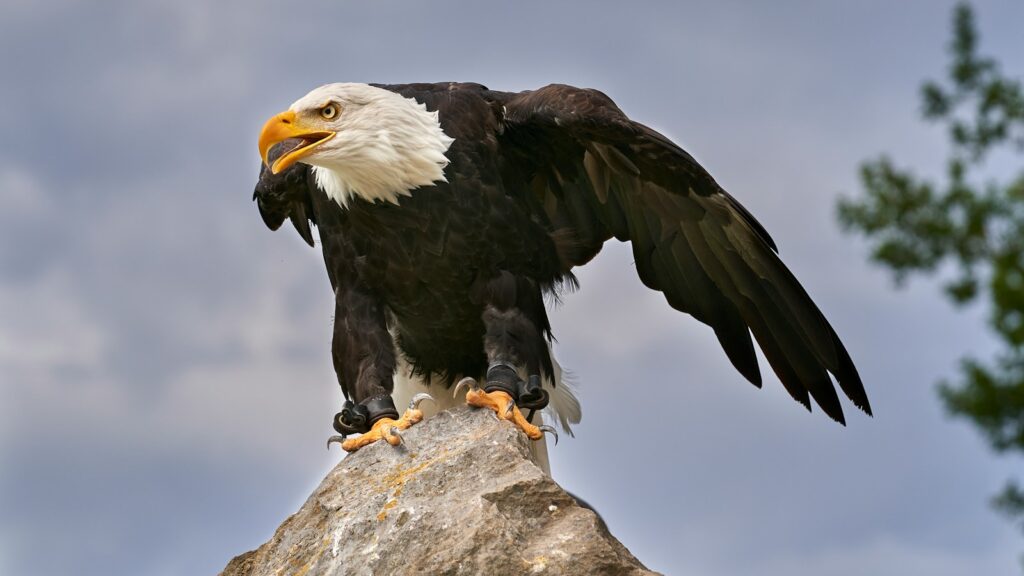
The Bald Eagle stands as perhaps America’s most recognizable bird of prey, with its distinctive white head, yellow beak, and impressive 7-foot wingspan. Once endangered due to DDT poisoning and habitat loss, these magnificent birds have made a remarkable recovery and can now be spotted near lakes, rivers, and coastal areas in nearly every state. They’re particularly abundant in Alaska, the Pacific Northwest, the Great Lakes region, and Florida, where they build massive nests that can weigh up to a ton after years of use. Bald Eagles primarily hunt fish but are opportunistic feeders that will also take waterfowl, small mammals, and even scavenge carrion when necessary. Their piercing calls and spectacular fishing dives, where they can reach speeds of 100 mph, make spotting one an unforgettable wildlife experience for any observer.
Red-tailed Hawk: The Ubiquitous Roadside Hunter
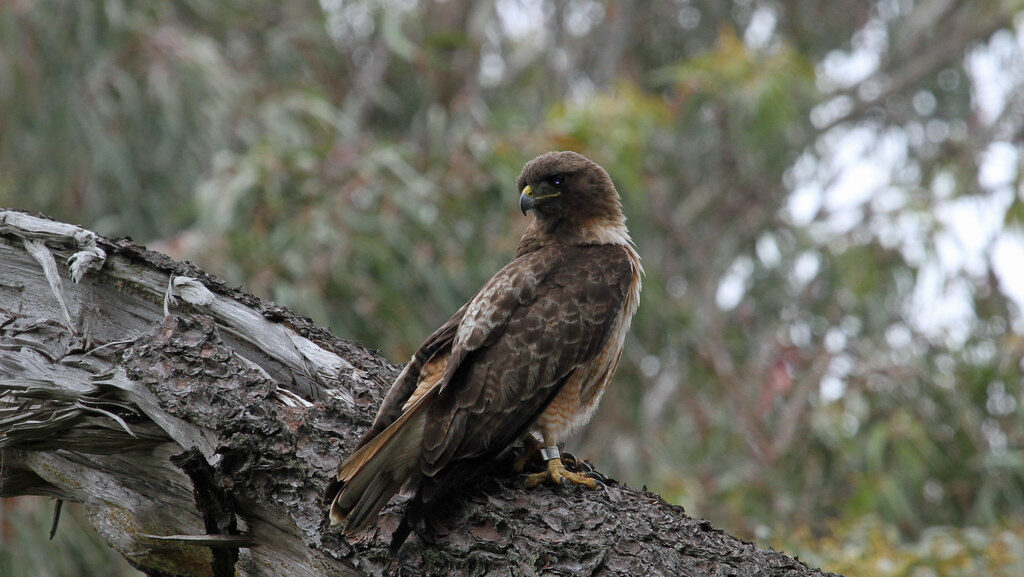
The Red-tailed Hawk reigns as North America’s most common and widespread hawk, recognizable by its brick-red tail and the dark band across its belly when perched. These adaptable raptors inhabit diverse landscapes from desert scrublands to urban parks, making them visible to observers across all 48 contiguous states throughout the year. Red-tailed Hawks frequently perch on telephone poles, fence posts, and trees along highways, scanning for prey with their exceptional vision that can spot a mouse from 100 feet in the air. Their haunting, raspy scream—often used as a generic “hawk sound” in movies regardless of species—carries across open landscapes as they soar on thermal currents. Many urban areas host resident Red-tailed Hawks that have adapted to city life, nesting on building ledges and hunting pigeons, making them perhaps the easiest raptor for most Americans to observe regularly.
Great Horned Owl: The Silent Night Hunter
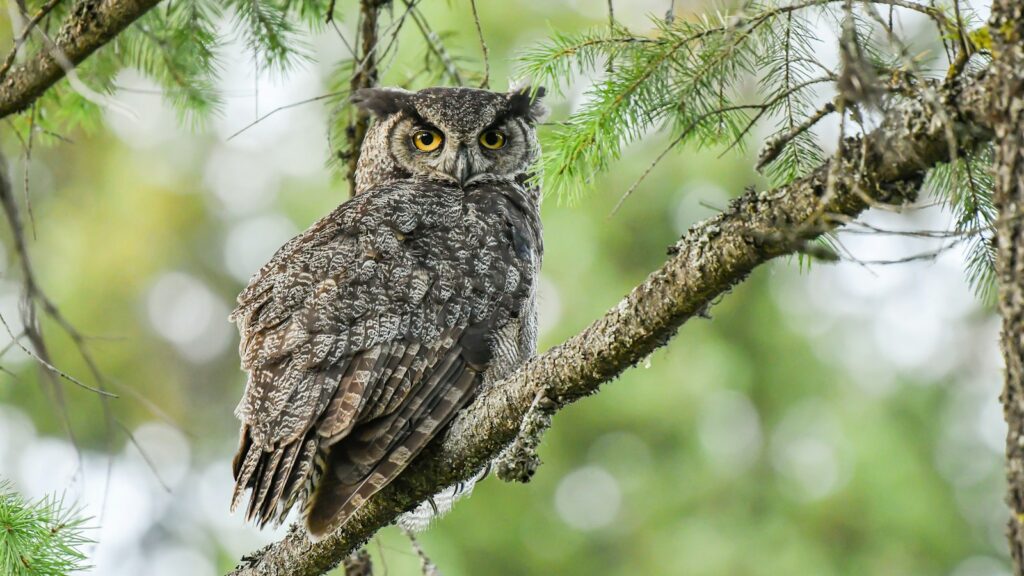
The Great Horned Owl, with its distinctive ear tufts (which aren’t actually ears) and resonant hooting call, is North America’s most widespread owl species, found in nearly every habitat from deep forests to desert canyons and suburban neighborhoods. These powerful nocturnal hunters possess exceptional adaptations, including specialized feathers that enable silent flight and eyes so large they cannot move in their sockets, forcing the owl to turn its entire head—up to 270 degrees—to change its gaze. Great Horned Owls are apex predators capable of taking prey larger than themselves, including skunks, rabbits, and even other raptors, earning them the nickname “tiger of the sky.” Listen for their distinctive “who-who-who whooo whooo” calls beginning at dusk in wooded areas year-round, or look for their silhouettes against the night sky as they hunt from prominent perches after sunset.
American Kestrel: The Colorful Falcon
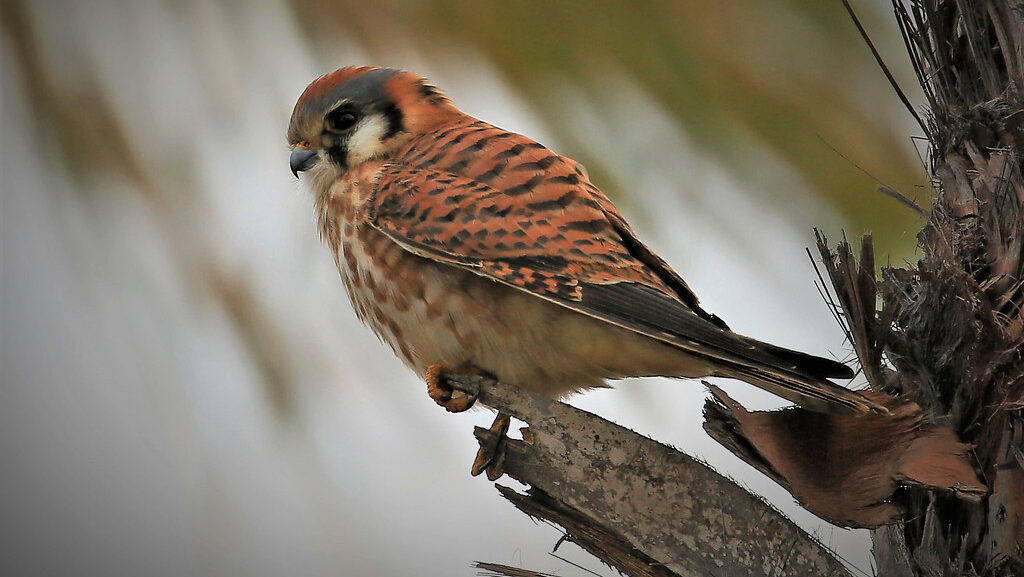
The American Kestrel, North America’s smallest and most colorful falcon, displays striking blue-gray wings and rusty backs and tails, with males featuring slate-blue head markings that distinguish them from their more uniformly rusty female counterparts. Despite measuring only about the size of a Blue Jay (9-12 inches long), these diminutive hunters possess the speed and precision characteristic of all falcons, capable of hovering perfectly still in midair while scanning for grasshoppers, mice, and small birds below. American Kestrels frequently perch on telephone wires and fence posts in open areas like farmlands, meadows, and desert edges, making them relatively easy to spot across the continental United States year-round. Their high-pitched “klee-klee-klee” calls and habit of pumping their tails while perched help observers identify these charismatic small raptors, which have adapted well to human landscapes and can even be found hunting in city parks.
Osprey: The Fish Hawk
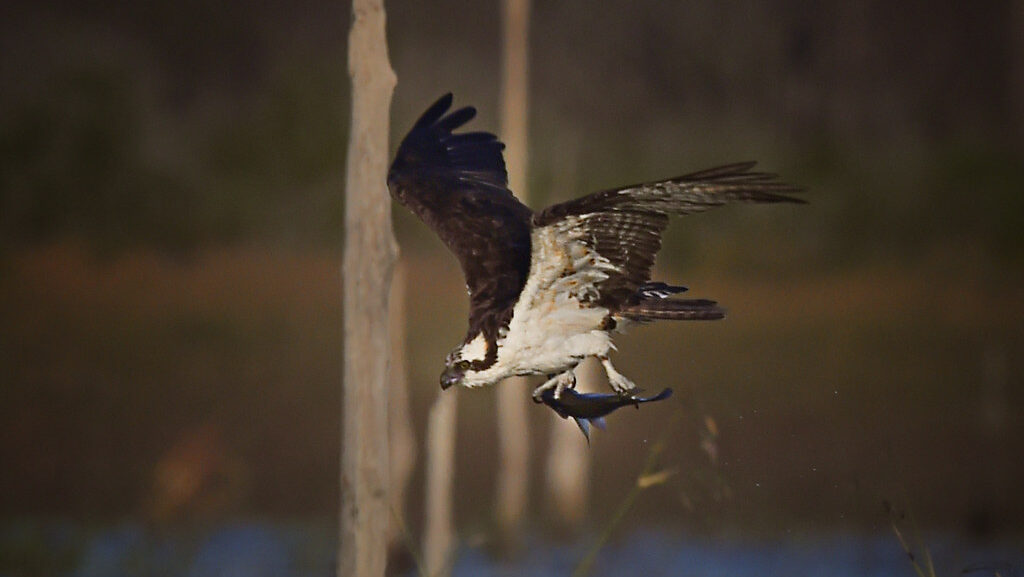
The Osprey stands as nature’s specialized fish hunter, equipped with unique adaptations including reversible outer toes, barbed footpads, and dense, oily plumage that prevents waterlogging during their spectacular fishing dives. These distinctive raptors—with white underbodies, dark brown backs, and wings that form an characteristic M-shape in flight—can be spotted near virtually any body of water containing fish, from coastal areas to inland lakes and rivers across most of the United States during summer months. Their impressive hunting technique involves hovering 50-100 feet above water before plunging feet-first, sometimes completely submerging to grasp fish with their specialized talons before dramatically shaking off water and reorienting their catch headfirst for aerodynamic flight. Ospreys have benefited tremendously from conservation efforts, including artificial nesting platforms constructed near waterways, making them increasingly common sights throughout their range and particularly abundant along the Atlantic coast, Florida, and the Pacific Northwest.
Cooper’s Hawk: The Backyard Bird Hunter
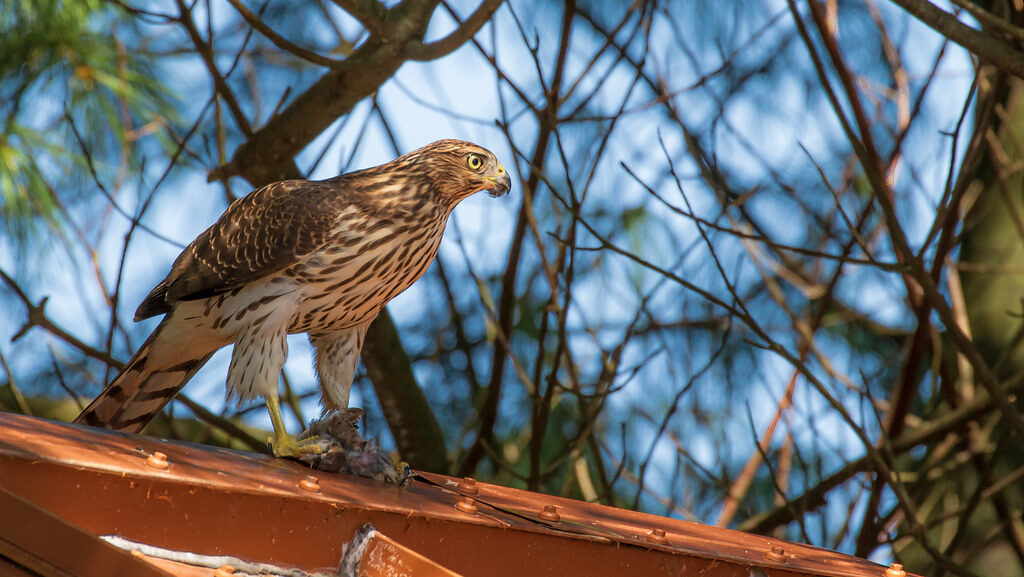
The Cooper’s Hawk has adapted remarkably well to suburban environments, making it one of the most likely birds of prey to visit residential areas where it hunts songbirds attracted to backyard feeders. These medium-sized hawks feature slate-gray backs, rusty barred underparts, and relatively long tails with rounded ends that help distinguish them from the similar but smaller Sharp-shinned Hawk. Cooper’s Hawks are woodland specialists with short, rounded wings and long tails that allow for exceptional maneuverability through tree canopies as they pursue prey at high speeds—a hunting strategy that sometimes results in window collisions as they chase birds. Their population has rebounded significantly from mid-20th century declines, and they’ve increasingly moved into urban and suburban areas across the continental United States, where they build stick nests in mature trees and can be observed year-round in most regions. Their presence near bird feeders often announces itself through the sudden disappearance of songbirds and the distinctive alarm calls of their potential prey.
Peregrine Falcon: The Urban Speed Demon
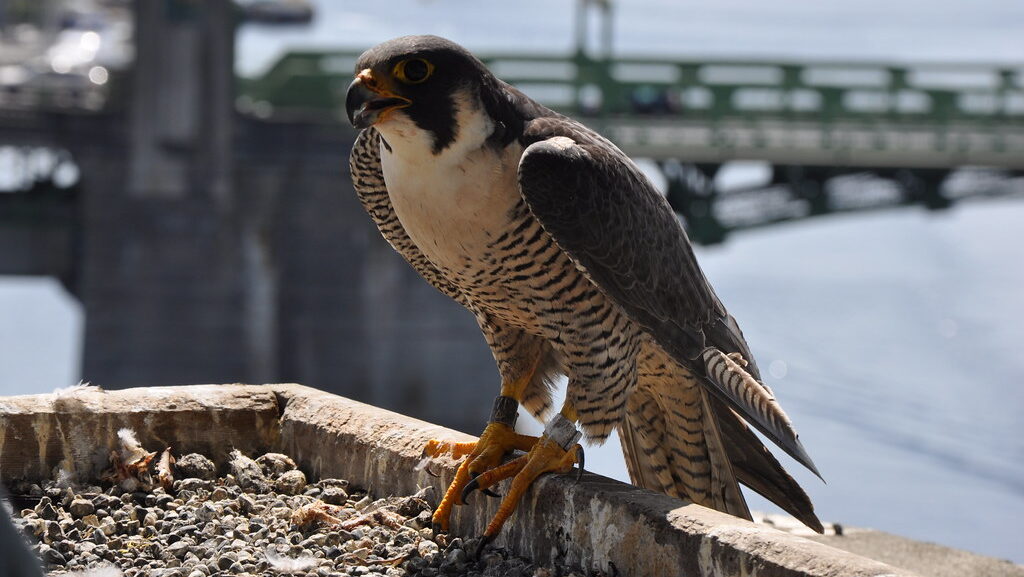
The Peregrine Falcon holds the title of fastest animal on Earth, capable of reaching speeds over 240 mph during hunting dives called “stoops” as they target flying birds in mid-air. These sleek, powerful falcons—characterized by their dark “helmet” markings, blue-gray backs, and barred underparts—have made a remarkable recovery from near-extinction in the mid-20th century due to DDT poisoning and now thrive in cities across America where they nest on skyscrapers, bridges, and other tall structures that mimic their natural cliff habitats. Urban Peregrines have adapted to hunt pigeons, starlings, and other city birds, making them visible in major metropolitan areas from New York to San Francisco, where organized “falcon watches” during nesting season allow observers to witness these spectacular hunters. Their incredible vision allows them to spot prey from nearly a mile away, while specialized respiratory and circulatory adaptations enable them to withstand the extreme forces experienced during their high-speed hunting dives, making them among the most specialized aerial predators in the world.
Barred Owl: The Vocal Forest Dweller

The Barred Owl, with its soulful dark eyes and distinctive “who-cooks-for-you, who-cooks-for-you-all” hooting call, inhabits dense forests and wooded swamps primarily in eastern and northwestern United States. These large, stocky owls lack ear tufts and display beautiful brown and white barring patterns across their chest (giving them their name) and vertical streaking on their belly, making them one of the most identifiable owls when seen. Unlike many raptors, Barred Owls are relatively vocal even during daylight hours, particularly at dawn and dusk, making them easier to locate by sound before spotting their stocky silhouettes in forest canopies. Their range has expanded westward over the past century as they’ve adapted to second-growth forests and even suburban woodlots, bringing them into contact with the similar-looking but endangered Spotted Owl in the Pacific Northwest. Year-round residents throughout their range, Barred Owls maintain territories that they defend vigorously with their remarkable vocal repertoire that includes hoots, cackles, and even monkey-like screams during courtship or territorial disputes.
Northern Harrier: The Gliding Grassland Hunter
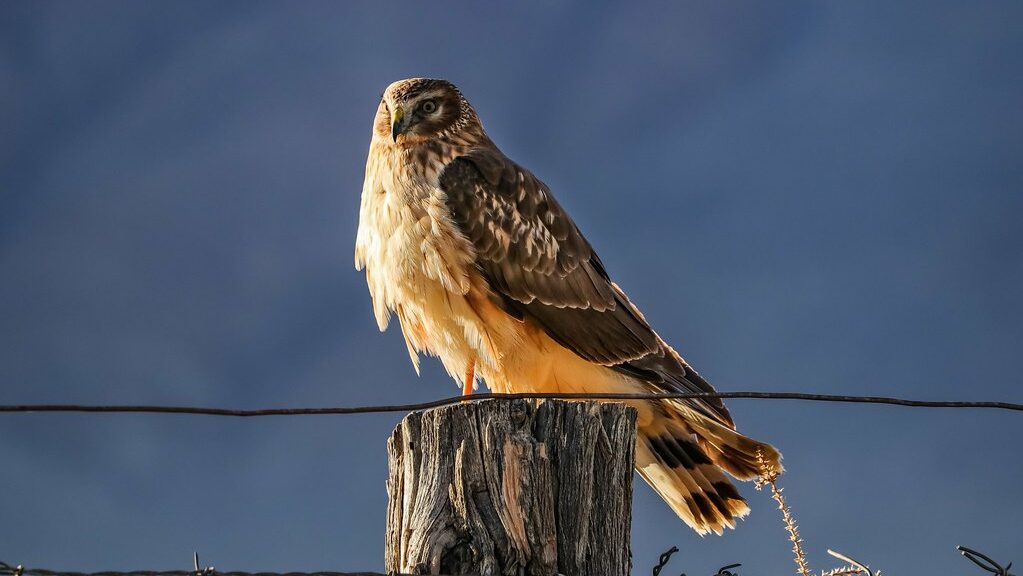
The Northern Harrier employs a distinctive low-gliding hunting style over open grasslands, marshes, and meadows, holding its wings in a shallow V-shape as it cruises just feet above the vegetation listening for prey. Unlike most North American raptors, Harriers display obvious sexual dimorphism—males are gray above and white below (earning the nickname “gray ghost”), while females and juveniles are brown with heavily streaked underparts. Their owl-like facial discs channel sound to their ears, allowing them to locate small mammals in dense grass primarily by sound—a hunting strategy unique among American hawks. Northern Harriers can be spotted throughout the continental United States, with northern populations migrating south for winter while southern birds remain year-round residents in suitable habitats. Their graceful, tilting flight pattern as they quarter low over open fields makes them relatively easy to identify even from a distance, particularly in prairie states, coastal marshes, and agricultural areas where they hunt voles, mice, and small birds.
Turkey Vulture: Nature’s Cleanup Crew
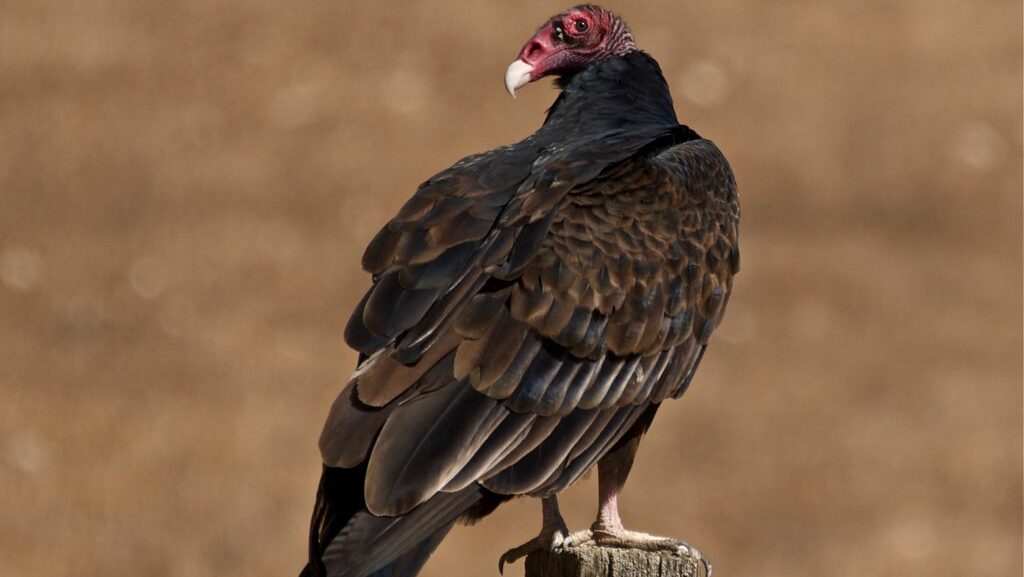
While some might not immediately classify vultures as birds of prey, these remarkable scavengers play a crucial ecological role and display many raptor characteristics that earn them a place on this list. Turkey Vultures, with their distinctive red, featherless heads and six-foot wingspans, soar effortlessly on thermal currents across every state except Alaska, often holding their wings in a slight V-shape (dihedral) and rocking side to side as they ride air currents. Unlike most birds, Turkey Vultures possess an extraordinary sense of smell that allows them to detect carrion from over a mile away, even through forest canopy, leading them to roadkill and other dead animals that they help remove from the ecosystem. Their bare heads serve a hygienic purpose, preventing bacteria and gore from adhering to feathers when they insert their heads into carcasses, while their corrosive stomach acid neutralizes dangerous bacteria like botulism that would sicken other animals. Despite their somewhat unsettling appearance and feeding habits, Turkey Vultures are completely harmless to living creatures and provide invaluable ecosystem services by reducing disease transmission and recycling nutrients.
Snowy Owl: The Winter Visitor
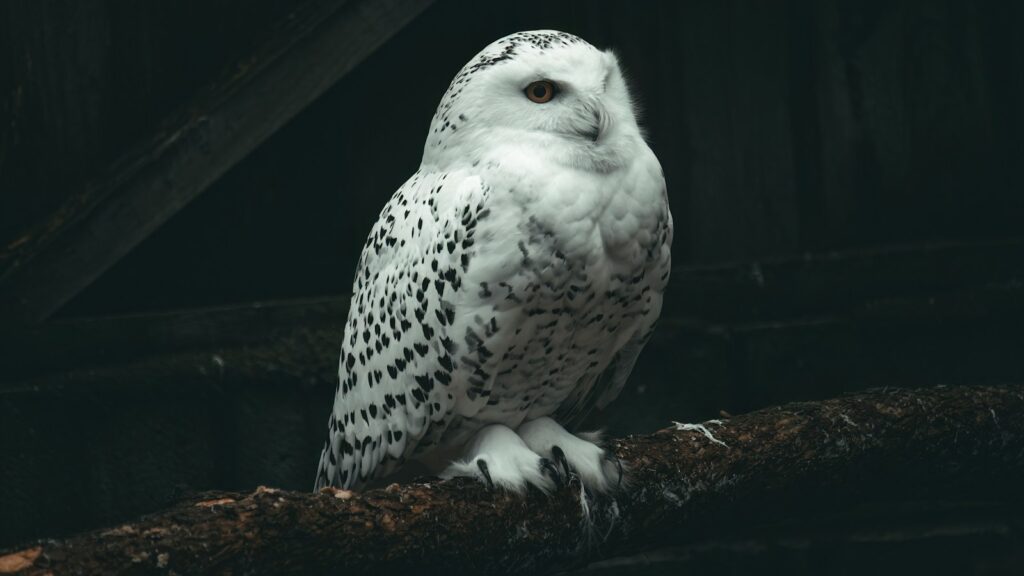
While not year-round residents, Snowy Owls make periodic winter appearances in the northern United States during “irruption years” when population booms or food shortages in their Arctic breeding grounds push them southward. These magnificent, predominantly white owls with amber eyes and variable black barring stand as North America’s largest owl by weight, capable of taking prey as large as geese and regularly hunting birds and mammals active during daylight hours, unlike most nocturnal owl species. Snowy Owls prefer open habitats reminiscent of their Arctic tundra home, making airports, coastal dunes, large fields, and even beach areas prime viewing locations during winter months, particularly in states bordering Canada from Maine to Washington. Unlike most owls, Snowies are primarily diurnal (day-active), making them easier to observe as they perch prominently on fence posts, hay bales, or small rises in the landscape while scanning for prey. Their periodic southern appearances create “owl fever” among birders and photographers who track sightings through online networks, sometimes traveling hundreds of miles for a chance to observe these charismatic Arctic visitors.
Where and How to Spot Birds of Prey

Successful raptor watching begins with understanding when and where these birds are most active, with many species most visible during morning and late afternoon hours when they actively hunt. Open areas with scattered perches—such as agricultural fields, grasslands with fence posts, and roadside corridors—offer excellent opportunities to spot hunting raptors like Red-tailed Hawks and American Kestrels as they scan for prey from elevated positions. Waterways attract fishing specialists like Ospreys and Bald Eagles, particularly during fish spawning seasons or near dams where fish concentrate. Specialized equipment enhances the experience but isn’t strictly necessary—while binoculars help immensely with identification, many raptors can be spotted with the naked eye and identified by silhouette, flight pattern, and habitat. Local Audubon chapters, wildlife refuges, and birding festivals often offer guided raptor walks with experienced leaders who can help newcomers locate and identify different species while explaining their ecological roles and behaviors. Remember to maintain appropriate distances to avoid disturbing these birds, particularly during sensitive nesting periods, and never approach active nests which can cause parents to abandon their young.
Conclusion
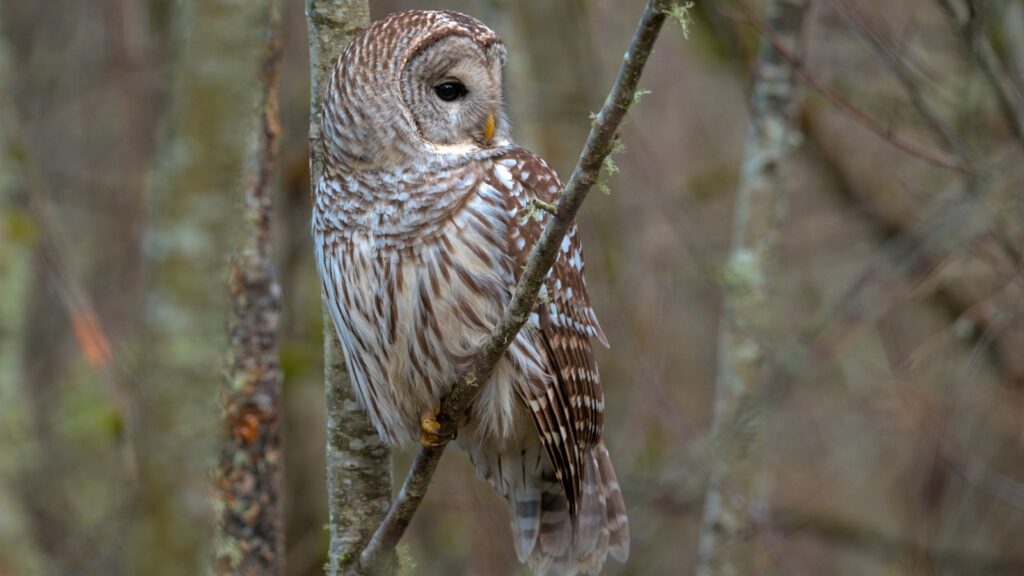
America’s diverse landscapes provide habitat for an impressive variety of birds of prey, from the soaring Bald Eagle to the forest-dwelling Barred Owl. These magnificent hunters not only inspire awe with their specialized adaptations and hunting prowess but also serve as indicators of ecosystem health. As many raptor populations recover from historical declines, opportunities to observe these birds continue to improve across the country. Whether you’re scanning suburban parks for Cooper’s Hawks, watching Ospreys plunge for fish along coastal waterways, or glimpsing the silent flight of a Great Horned Owl at dusk, connecting with these remarkable predators offers a profound reminder of the wild nature that surrounds us—even in our own backyards. By learning to recognize and appreciate these ten accessible species, you can begin a lifelong journey of raptor appreciation without traveling far from home.
